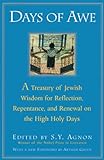Yom Kippur 1896 / יוֹם כִּפּוּר 5657
Day of Atonement ✡️
Yom Kippur for Hebrew Year 5657 began on and ended on .

Yom Kippur (Hebrew: יוֹם כִּפּוּר or יום הכיפורים), Also known as Day of Atonement, is the holiest day of the year for the Jews. Its central themes are atonement and repentance. Jews traditionally observe this holy day with a 25-hour period of fasting and intensive prayer, often spending most of the day in synagogue services. Yom Kippur completes the annual period known in Judaism as the High Holy Days (or sometimes “the Days of Awe”).
Read more from Judaism 101 or Wikipedia
Advertisement
Dates for Yom Kippur
| Holiday | Starts | Ends | Hebrew Date |
|---|---|---|---|
| Yom Kippur 1893 | 10 Tishrei 5654 | ||
| Yom Kippur 1894 | 10 Tishrei 5655 | ||
| Yom Kippur 1895 | 10 Tishrei 5656 | ||
| Yom Kippur 1896 | 10 Tishrei 5657 | ||
| Yom Kippur 1897 | 10 Tishrei 5658 | ||
| Yom Kippur 1898 | 10 Tishrei 5659 | ||
| Yom Kippur 1899 | 10 Tishrei 5660 | ||
| Yom Kippur 1900 | 10 Tishrei 5661 |
Tanakh
Yom Kippur
/ יוֹם כִּפּוּר
Torah Portion: Leviticus 16:1-34; Numbers 29:7-11
- 1: Leviticus 16:1-6 · 6 p’sukim
- 2: Leviticus 16:7-11 · 5 p’sukim
- 3: Leviticus 16:12-17 · 6 p’sukim
- 4: Leviticus 16:18-24 · 7 p’sukim
- 5: Leviticus 16:25-30 · 6 p’sukim
- 6: Leviticus 16:31-34 · 4 p’sukim
- maf: Numbers 29:7-11 · 5 p’sukim
Haftarah: Isaiah 57:14-58:14 · 22 p’sukim
Yom Kippur (Mincha)
/ יוֹם כִּפּוּר מִנחָה
Torah Portion: Leviticus 18:1-30
- 1: Leviticus 18:1-5 · 5 p’sukim
- 2: Leviticus 18:6-21 · 16 p’sukim
- maf: Leviticus 18:22-30 · 9 p’sukim
Haftarah: Jonah 1:1-4:11; Micah 7:18-20 · 51 p’sukim
References
- The Jewish Holidays: A Guide & Commentary (paid link)
- Rabbi Michael Strassfeld
- Tanakh: The Holy Scriptures (paid link)
- Jewish Publication Society
- Sefaria Tanakh
- Sefaria.org
- “Yom Kippur” in Wikipedia: The Free Encyclopedia
- Wikimedia Foundation Inc.
Books (paid links)

Days of Awe
by Shmuel Yosef Agnon

This Is Real and You Are Completely Unprepared
by Rabi Alan Lew

Entering the High Holy Days
by Rabbi Reuven Hammer
When you buy a book using a link on this page, we receive a commission. Thank you for supporting Hebcal.
